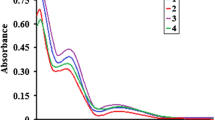Summary
Mixed-ligand complexes formed by reaction of Cu(ClO4)2 with 3-(2-pyridyl)-5,6-diphenyl-1,2,4-triazine (dppt) as primary ligand and 2,2′-bipyridine (bipy), 1,10-phenanthroline (phen), 2,9-dimethyl-1,10-phenanthroline (dmp), N,N-bis(pyrid-2-ylmethyl)amine (dipica), N,N-bis(benzimidazol-2-ylmethyl)amine (bba), 1,3-bis(2-benzimidazolyl)-2-thiapropane (bbms) and 1,5-bis(benzimidazolyl)-3-thiapentane (bbes) as the secondary ligands have been isolated. They are of the type [Cu(dppt)L](ClO4)2·nH2O, where n = 0 or 2. All complexes exhibit only one ligand field band and their cryogenic solution e.p.r. spectra are axial, with vmax and g ∥ values diagnostic of a square-based geometry. The spectral and redox data are consistent with facial coordination of the tridentate ligands. All the complexes exhibit a positive redox potential (versus n.h.e.). The weak σ-bonding of dppt, caused by the highly electron-withdrawing phenyl rings, the strong π-back bonding involving phen and dmp, and interligand repulsions appear to be responsible for the relatively positive CuII/CuI redox potentials.
Similar content being viewed by others
References
C. M. Groeneveld, J. van Rijn, J. Reedijk and G. W. Canters, J. Am. Chem. Soc., 110, 4893 (1988); T. Pandiyan, M. Murali and M. Palaniandavar, Transition Met. Chem., 20, 440 (1995).
L. Casella, M. Gullotti, A. Pintar, F. Pinciroli, R. Vigano and P. Zanello, J. Chem. Soc., Dalton Trans., 1161 (1989).
A. W. Addison, T. N. Rao, J. Reedijk, J. van Rijn and G. C. Verschoor, J. Chem. Soc., Dalton Trans., 1349 (1984).
R. P. F. Kanters, R. Yu and A. W. Addision, Inorg. Chim. Acta, 196, 97 (1992).
J. M. Guss and H. C. Freeman, J. Molec. Biol., 169, 521 (1983).
E. N. Baker, J. Molec. Biol., 203, 1071 (1988).
J. M. Downes, J. Whelan and B. Bosnich, Inorg. Chem., 20, 1081 (1981).
N. Kitajima, K. Fujisawa, M. Tanaka and Y. Moro-oka, J. Am. Chem. Soc., 114, 9232 (1992) and refs cited therein.
U. Sivagnanam and M. Palaniandavar, J. Chem. Soc., Dalton Trans., 2277 (1994).
J. van Rijn, W. L. Driessen, J. Reedijk and J. M. Lehn, Inorg. Chem., 23, 3584 (1984).
P. J. M. W. L. Birker, J. Helder, G. Henkel, B. Krebs and J. Reedijk, Inorg. Chem., 21, 357 (1982).
M. Palaniandava and A. W. Addison, Unpublished work.
J. Whelan and B. Bosnich, Inorg. Chem., 25, 3671 (1986).
A. W. Addison, T. N. Rao and E. Sinn, Inorg. Chem., 23, 1957 (1984).
P. J. Burke, K. Henrick and D. R. McMillin, Inorg. Chem., 21, 1881 (1982).
R. Uma, M. Palaniandavar and R. J. Butcher, Unpublished work.
J. K. Romary, R. D. Zachariasen, J. D. Barger and H. Schiesser, J. Chem. Soc., 2884 (1968).
U. Sivagnanam, T. Pandiyan and M. Palaniandavar, Indian J. Chem., 32B, 572 (1993).
A. W. Addison and P. J. Burke, J. Heterocycl. Chem., 18, 803 (1981).
J. V. Dagdigian and C. A. Reed, Inorg. Chem., 18, 2623 (1979).
M. Palaniandavar, R. J. Butcher and A. W. Addison, Unpublished work.
M. Palaniandavar, T. Pandiyan, M. Lakshminarayanan and H. Manohar, J. Chem. Soc., Dalton Trans., 455 (1995) and refs cited therein.
T. Pandiyan, M. Palaniandavar, M. Lakshminarayanan and H. Manohar, J. Chem. Soc., Dalton Trans., 3377 (1992) and refs cited therein.
D. X. West and M. Palaniandavar, Inorg. Chim. Acta, 76, L149 (1983).
Y. Nonaka, T. Toku and S. Kida, Bull. Chem. Soc. Japan, 47, 312 (1974).
H. Nakai and Y. Noda, Bull. Chem. Soc. Japan, 51, 1386 (1978) and refs cited therein.
A. W. Addison, P. J. Burke, K. Henrick, T. N. Rao and E. Sinn, Inorg. Chem., 22, 3645 (1983).
H. J. Schugar in K. D. Karlin and J. A. Zubieta (Eds), Copper Coordination Chemistry: Biochemical and Inorganic Perspectives, Academic Press, Guilderland, New York 1983, p. 49.
B. J. Hathaway and D. E. Billing, Coord. Chem. Rev., 5, 143 (1970).
A. W. Addison, M. Carpenter, L. K. M. Lau and M. Wicholas, Inorg. Chem., 17, 1545 (1978).
U. Sakaguchi and A. W. Addison, J. Chem. Soc., Dalton Trans., 600 (1979).
M. Murali, M. Palaniandavar and T. Pandiyan, Inorg. Chim. Acta, 224, 19 (1994).
A. J. Bard and L. R. Faulkner, in Electrochemical Methods: Fundamental Applications, Wiley, New York, 1980, p. 218.
Author information
Authors and Affiliations
Rights and permissions
About this article
Cite this article
Murali, M., Palaniandavar, M. Mixed-ligand copper(II) complexes with positive redox potentials. Transition Met Chem 21, 142–148 (1996). https://doi.org/10.1007/BF00136544
Received:
Accepted:
Issue Date:
DOI: https://doi.org/10.1007/BF00136544




